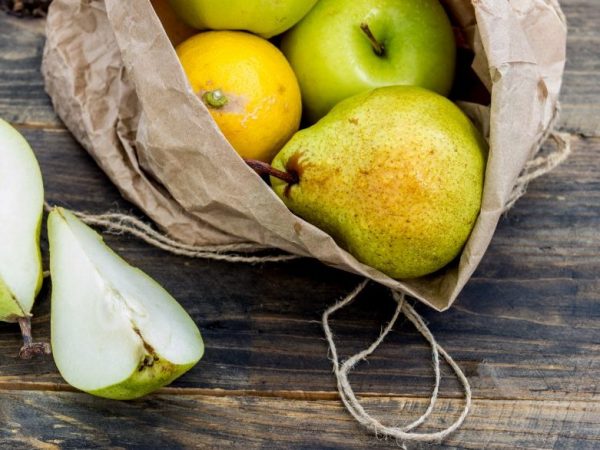Characteristics of the pear variety Bessemyanka
Pear is a popular fruit in our latitudes. Many are engaged in the cultivation of this tree in their garden plots, therefore there are a number of varieties. When choosing seeds for planting, Pear Bessemyanka deserves attention.

Characteristics of the pear variety Bessemyanka
Variety characteristic
Pear Bessemyanka is a unique variety, in the fruits of which there are no formed seeds. It has a sweet honey taste, which is why it is also called sugar.
This variety is not picky about the soil, but does not tolerate excessive moisture.
The pear variety Bessemyanka is resistant to temperature changes, has excellent fertility for 30 years - up to 50 kg from 1 tree. After that, it requires special care and rejuvenation (cutting dry trunks). This variety is the most vulnerable to scab, therefore, it requires regular preventive procedures.
Begins to bear fruit 10 years after planting. Despite the late fertility, the yield is at the highest level. Regular harvesting allows you to collect up to 250 kg from 4 sq. m.
Description of the tree
The crown of the tree has a pyramidal shape. The bark and branches of the pear are gray-brown. Medium durability - strong wind can easily break them. The branches stretch upwards, and also have a huge number of small lentils.
Leaves are ovoid, wavy, with an oblong petiole. The bloom is white, consists of small flowers of 5 petals. They are located at a short distance from each other.
Description of fruits
Fruit ripening begins around the end of summer. Ripe, the pear quickly crumbles. The fruit is stored for 10 days. The fruits are harvested a little underripe. Otherwise, they can overripe and lose their honey flavor.

Description of fruits
Pear Bessemyanka has the following characteristics:
- small size (maximum weight - 80 g);
- green with yellow;
- the skin is covered with black dots, sometimes with orange spots;
- the pulp is sweet, slightly granular;
- honey taste, juicy;
- the peduncle is thin, of medium length.
Care
It is customary to plant the variety at the very beginning of spring and until the moment when buds appear on the trees, or in autumn, at the beginning of October and before the first frosts appear.
A pit (1 m deep) for this pear variety must be prepared in advance. 5 days after planting, the seedling needs care:
- frequent, but not abundant soil moisture;
- mulching with shavings;
- fertilizer;
- pruning dry branches;
- crown formation.
Young roots are very sensitive in winter and need high-quality insulation. The best option is snow.
It is also important to ensure that the near-trunk area is not overgrown with weeds. You can plant lupines in your garden to help enrich the soil.
Watering
The best watering is rain. It is advised to water the tree yourself several times a year: in late spring and in the middle of summer, during a severe drought. On average, you need 5-7 liters of water for 1 adult tree.
After moistening, it is necessary to loosen the soil so that oxygen better flows to the roots. This stimulates the growth of the root system.
Top dressing
Fertilization must be carried out from the second year after the appearance of the first fruits. Mainly, top dressing is applied in autumn and spring.
Mineral fertilizers must be applied annually. Organic type podviks are introduced not so often - once every 3 years.

Pear care
Mulching
It is recommended to fertilize the soil with peat or humus. For mulching, sawdust, dry grass, straw, paper, stone are used. Using dry (not rotten) leaves enriches the soil with humus and nutrients, but composting is necessary before using them. Compost provides drainage and controls soil evaporation.
Pests and diseases
The Bessemyanka variety is resistant to some popular diseases and pests of pear trees:
- aphids suck out all the juices from the leaves, the result of this is the deformation of the shoots;
- the stalk affects the internal structure of the fruit, is capable of rapid reproduction;
- the flies spoil the fruit and destroy the buds;
- the pear mite spoils the foliage, as a result, the leaves are deformed;
- leafworm lives on leaf plates, because of this, the leaves curl and dry quickly.
The processing of the crown and trunk from the presented pests is carried out using a number of drugs:
- "Agravertine" against aphids;
- "Kinmix" for the fight against the peduncle and leaf beetle;
- Colloidal sulfur saves from ticks.
For the prevention of diseases, it is necessary to ensure good ventilation of the crown, that is, to cut it regularly. Leaves fallen in autumn must be burned without fail. Also, rotten fruits should not be left on the ground.
Conclusion
The Bessemyanka pear variety is characterized by frost resistance and endurance in dry season. The main disadvantage is the short shelf life.
The fruits are great for fresh consumption and for making jam or stewed fruit. Suitable for drying. They are often used to make fruit salads or slices. Their honey flavor makes them great for sweet dessert wines.


